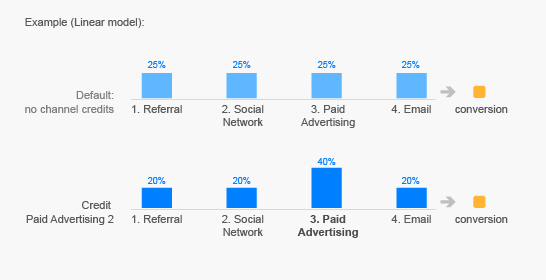Marketing Channel Attribution
Today marketers have access to boat loads of data. They can obtain anything from brand impressions your marketing channels have collected all the way to how many conversion actions have been completed on your site.
Regardless of how much data you have it doesn’t matter unless you leverage the data correctly to continually increase the performance of your marketing efforts. The ultimate goal to reach your target consumer better at a more efficient price is now truly becoming possible. In the past I have written about ZMOT, the idea that consumers today have an increased understanding of the digital space and often don’t complete conversion activities after viewing your site the first time (read more about ZMOT). With recent advancements in digital reporting suites such as Google Analytics we can pin point the value each marketing channel brings to our marketing mix. This goes beyond the eye of standard reporting with KPI’s such as CTR (Click-through-Rate) and impressions and focuses more on channel ROI.
Marketing channel attribution is the process of pinning a value to each interaction a consumer has with a marketing channel. The first step is to determine all of the channels you have, organic and paid. Once you have captured all of your digital and traditional channels in your analytics account it is time to start developing your attribution model.
There are many marketing attribution models available for marketers to leverage, but I personally believe your model needs to be adjusted to best fit your business objectives. As you all know I am a major Google fan boy so I will review the five main attribution models Google has recently released to the public.
EXAMPLE: A consumer discovers your brand by clicking through to your site from a paid online display ad. The consumer checks out your site and leaves without completing a conversion. Then two days later the same consumer searches for your brand in Google and clicks through to your site. The user while on your site signs up for your CRM email program and leaves again without completing a purchase transaction. One day later the same user receives an email from your CRM program and clicks through to your site from the email where they end up completing a transaction (conversion).
Last Interaction
This model is traditionally how most marketers have judged effectiveness of their marketing efforts. It is when the last channel used to complete a transaction gets all of the credit for the conversion. – In this example the paid email program would receive 100% of the credit.
First Interaction
This model gives 100% of the credit to the first channel that directs users to your site. – In the case above the paid display ad receives 100% of the value.
Linear
Each channel assisting in the conversion path receives an equal distribution of weight. – Paid display, organic search and email would all receive equal credit at 33% each.
Time Decay
In this model the channel closest in time to the final conversion transaction would receive the most credit. The total percentage of credit would decrease based on how much time has gone between the channel interaction and the conversion event. This model takes some additional effort to determine how you want to allocate points based on the time passed – Lets apply a simple Time Decay model to our example that attributes 50-30-20 at a 3 day transaction with a 5% shift for every day delayed. In our example each channel would be allocated the following:
- Email 50%
- Organic Search 40%
- Display Ad 10%
Position
This assigns a different value based on when the user interacts with a channel. The Position model has the most lenience allowing for you to adjust it to meet your unique business objectives. – Lets apply a simple model again to our example. Lets say the first interaction in worth 40%, middle interactions split 30% and the final interaction is allocated 30%. In our example the display ad gets 40%, organic search receives 30% (note if more channels in-between first and last interaction the 30% would be split between them) and the email channel receives 30%.
There are many different ways we can slice this pie, but it is important you understand the core models to develop an effective attribution model for your business. I would like to thank the Google Analytics team for making industry breaking strides in this space over the past year. Google has developed a great section on how to develop attribution models and how you can leverage Google Analytics to make these a reality. Please check out the articles and how-to guides at the link below!
https://support.google.com/analytics/bin/answer.py?hl=en&answer=1662518&topic=1191164&ctx=topic



Leave a comment